Sennheiser Ambeo Plus review: no minuses to be heard
The Ambeo Plus has no minus about its stellar sound quality. It is expensive for a single box solution, so is Sennheiser's soundbar worth it?


Remarkable scale and power from a relatively modestly sized soundbar, and a very convincing impression of spatial audio too. Sennheiser knows precisely what it’s doing with this technology, to the point that it seems perfectly reasonable for the company to slap a premium price on this product.
-
+
Sonic scale and punch to spare
-
+
Impressive spatial audio effect
-
+
Great control options
-
-
Can sound over-processed at times
-
-
Some very capable alternatives
-
-
Optimistic pricing
Why you can trust T3

The original Sennheiser Ambeo Dolby Atmos soundbar launched in 2019, with a chunky asking price (it was £2,199 in the UK). Yes, it was pretty much universally acclaimed, and sits among the best soundbars, but at that price its appeal was necessarily limited.
So Sennheiser, sensibly, has taken away some of the whistles and bells, some of the physical bulk, and a whole chunk of the asking price. And then, rather less sensibly, called the resulting product ’Ambeo Plus’. That's right: the smaller Ambeo soundbar has, for whatever reason, the word 'Plus' in its name.
But the name aside, the bigger question is: does taking stuff away really result in a ‘plus’ product? Here's our Sennheiser Ambeo Plus review to reveal all.
Sennheiser Ambeo Plus: Price & Availability
The Sennheiser Ambeo Plus Dolby Atmos soundbar is on sale now, and in the United Kingdom it costs £1,299. It goes for $1,499 in the United States, and around AU$2,399 in Australia.
So while it’s a sight more affordable than the original Sennheiser Ambeo soundbar (now rechristened ‘Ambeo Max’) and a sight less visually intrusive, too, this is still significant soundbar money.
Sonos will sell you its well-regarded Arc for maybe two-thirds of the price, while the likes of LG and Sony have very capable products of their own for less than Sennheiser wants for the Ambeo Plus. So what does the Sennheiser premium buy you, exactly?
Sennheiser Ambeo Plus review: What's new?
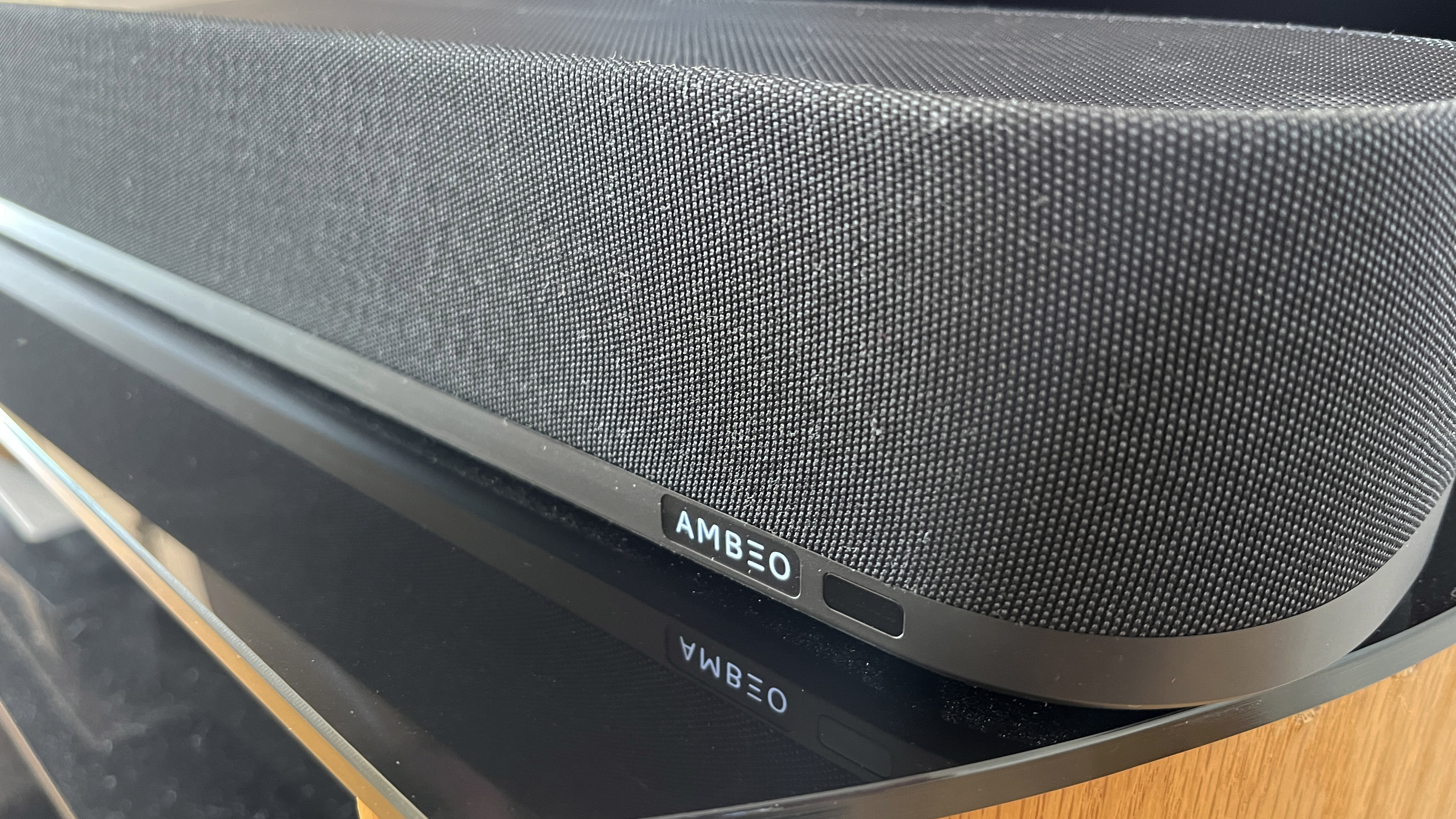
As seems only reasonable for a soundbar costing this much money, the Ambeo Plus is impressively and extensively specified. There are quite a few big numbers attached.
The ‘400 watts’, for example, is a big number in anyone’s soundbar language. Nine Class D blocks of amplification churn it out, powering nine individual speaker drivers. On the top surface, either side of the touch-controls, are four upward-facing drivers - a pair of 102mm cellulose drivers sit outside a couple of 51mm aluminium full-range drivers. There is another of these smaller drivers at each end of the soundbar, firing outwards in an effort to generate some sonic width, and three more are arranged across the front of the soundbar facing more-or-less dead ahead. It’s from this arrangement that Sennheiser intends to liberate 7.1.4 spatial audio.
It’s probably worth mentioning at this point that Sennheiser will happily sell you its Ambeo Sub in order to bolster the soundbar’s low-frequency response.
It costs £599 or thereabouts, and it connects wirelessly to the soundbar - in fact, you can connect as many as four Ambeo Subs wirelessly if you so desire (and have no neighbours).
Do bear in mind that Sennheiser is claiming a frequency response down to 38kHz from Ambeo Plus - so a subwoofer may not be an automatic purchase.

As far as getting audio information on board the Ambeo Plus in the first place, your options are numerous. As far as wireless connectivity is concerned, there’s Bluetooth 5.0 (with SBC and AAC codec compatibility), and Spotify Connect, Tidal Connect, Apple AirPlay 2 and Google Chromecast are all built-in. The music player that’s integrated into the Sennheiser control app makes keeping on top of all these options easy.
Physical connections run to eARC via an HDMI 2.1 input, a pair of HDMI 2.0 sockets, digital optical (good for anything up to 192kHz resolution), an Ethernet socket and a pair of analogue stereo RCA inputs. There’s also a USB-A slot and a pre-out for hard-wiring a subwoofer.
The eARC HDMI 2.1 input is welcome, of course, because as well as accommodating Dolby Atmos in its higher True HD format, it also supports DTS:X and Sony 360 Reality Audio for object-based decoding.
But if you want to experience your games console at the full 4K at 120Hz it’ll have to be wired directly to your TV - and then you’ll have to hope your television has more than one HDMI 2.1 socket in order to make the eARC connection to the Ambeo Plus.
Sennheiser Ambeo Plus review: Performance
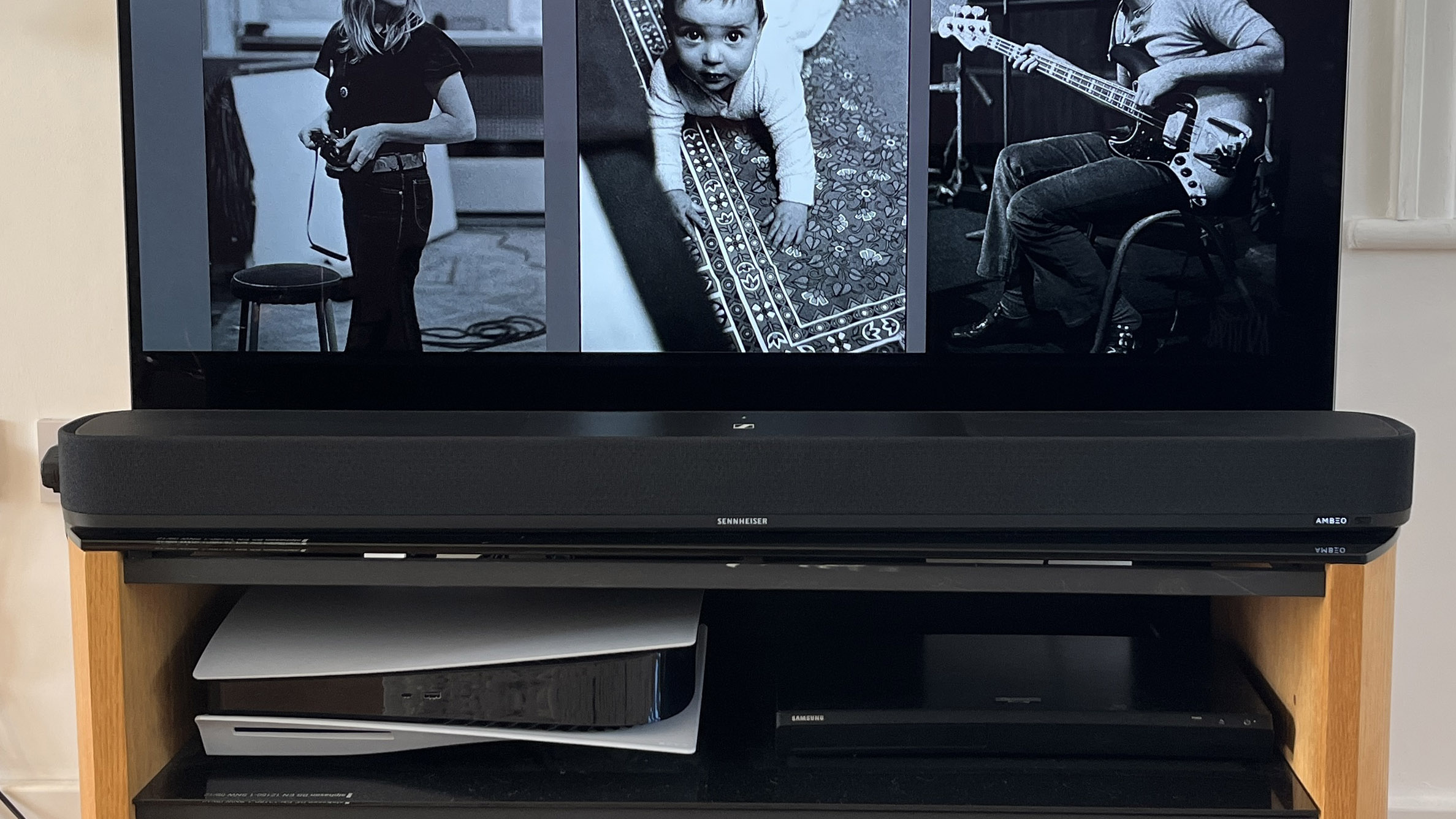
Yes, it’s much smaller than the original Ambeo soundbar and no, it’s not even as big as some of its best-regarded price-comparable rivals. But let there be no doubt: the Sennheiser Ambeo Plus is capable of effortless scale, and will fill all but the very largest listening rooms with balanced and convincingly cinematic sound.
That it does its best work with some native Dolby Atmos content should come as no surprise. Netflix and Disney+ both have quite an Atmos catalogue these days - and if you have a UHD 4K Blu-ray player that can deal with the spatial audio format, that’s even better. But no matter where you source your Dolby Atmos soundtracks from, the Ambeo Plus puts a rocket up them.
As far as low-frequency presence is concerned, you should think long and hard about that optional subwoofer. The Sennheiser digs deep, hits hard and has no trouble punching its way through the biggest, most explosive set-pieces to the point that it can rattle your ornaments. It’s no blunt instrument, though - there’s great variation and detail to bass sounds, and plenty of control. When the action kicks off, never doubt the Ambeo Plus can kick off right along with it.
There’s similar poise and impressive subtlety to the midrange, too. Dialogue projects well ahead of any mayhem that might be surrounding it, and the midrange is distinct and detailed enough to make even the most talky of movies easy to follow. Up at the top of the frequency range, meanwhile, there’s more bite and shine to treble sounds than may seem likely from a soundbar with no actual tweeters - and, again, more than enough detail to make the finest, most transient sounds plain.
The entire frequency range hangs together well, with no area understated and no area overplayed. It’s a coherent, and subsequently convincing, presentation in pretty much all circumstances.
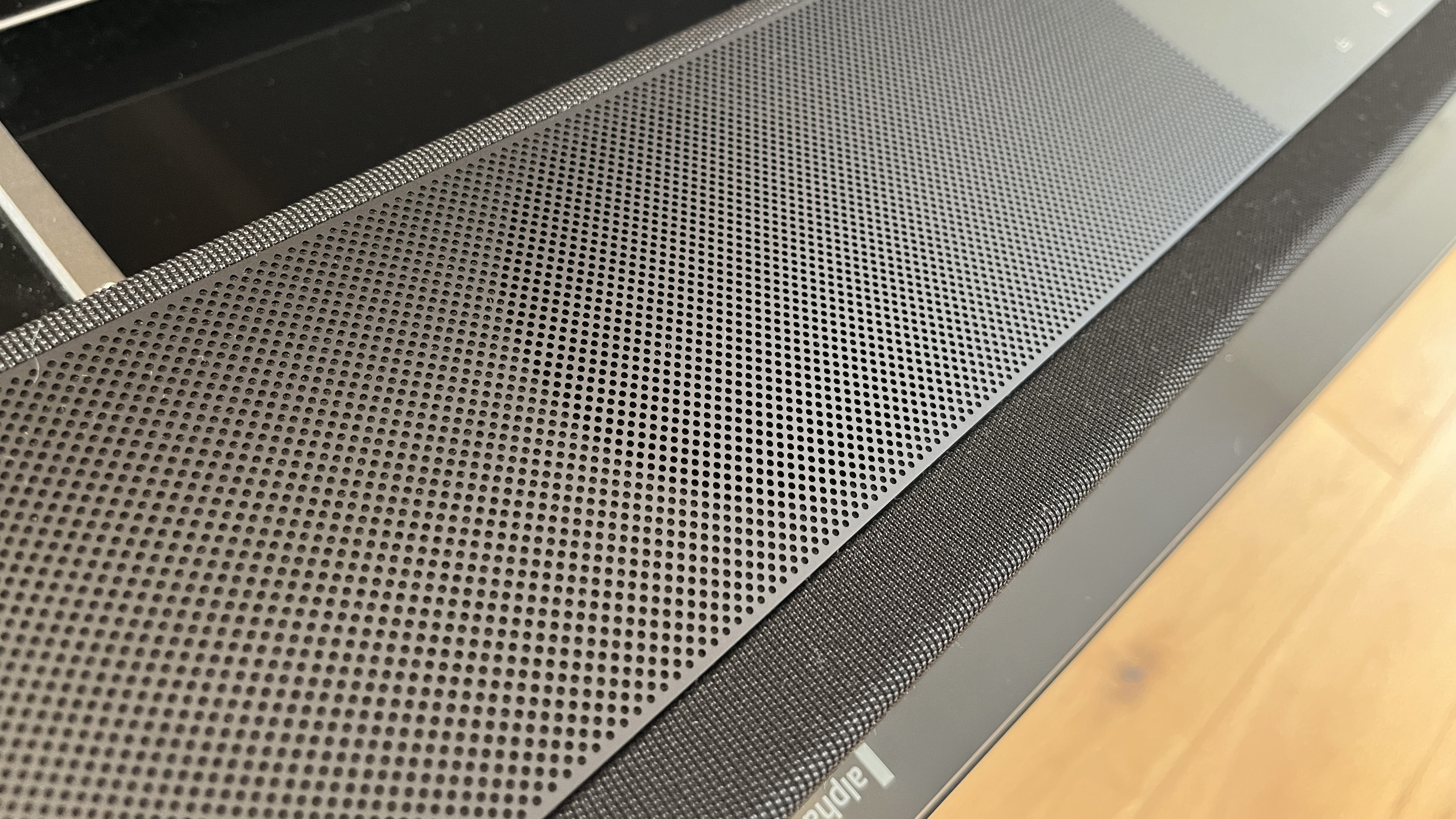
And where the spatial audio effect is concerned, the Ambeo Plus is as good as any sub-£2K soundbar around. Native Dolby Atmos soundtracks enjoy great depth and width to their soundstage, and those upward-firing drivers bring an undeniable sensation of height to the sound too. Focus is good, separation is solid, and the overall soundstage is confidently described. The Sennheiser Ambeo Max remains the spatial audio paradigm, but the Ambeo Plus is good enough to make its older sibling seem a bit fat and expensive.
All of the above assumes you’re listening to an Atmos soundtrack with the Sennheiser’s ‘Ambeo’ setting defeated. Turn it on when playing an Atmos soundtrack and there’s no doubt the stage gets even more spacious - but it also starts to sound a little diffuse and less-than-perfectly focused. ‘Ambeo’ is better deployed if you want some of that spatial audio sensation from non-Atmos content - its sound is big and enveloping when heard this way, even if it does get a little fuzzy around the edges. It’s best avoided altogether when watching small-scale or dialogue-centric movies, though - in its efforts to make everything sound wide and tall, ‘Ambeo’ can also make it sound vague and maybe even a little confused.
The Ambeo Plus is a very capable speaker when it comes to playing music, too. No matter if you’re watching a music video/film/documentary or streaming some tunes via Bluetooth, its low-frequency discipline means it expresses rhythms well - and those gratifyingly high detail levels are also in evidence. It handles dynamic variations and creates a believable soundstage.
Sennheiser Ambeo Plus review: Design & Usability
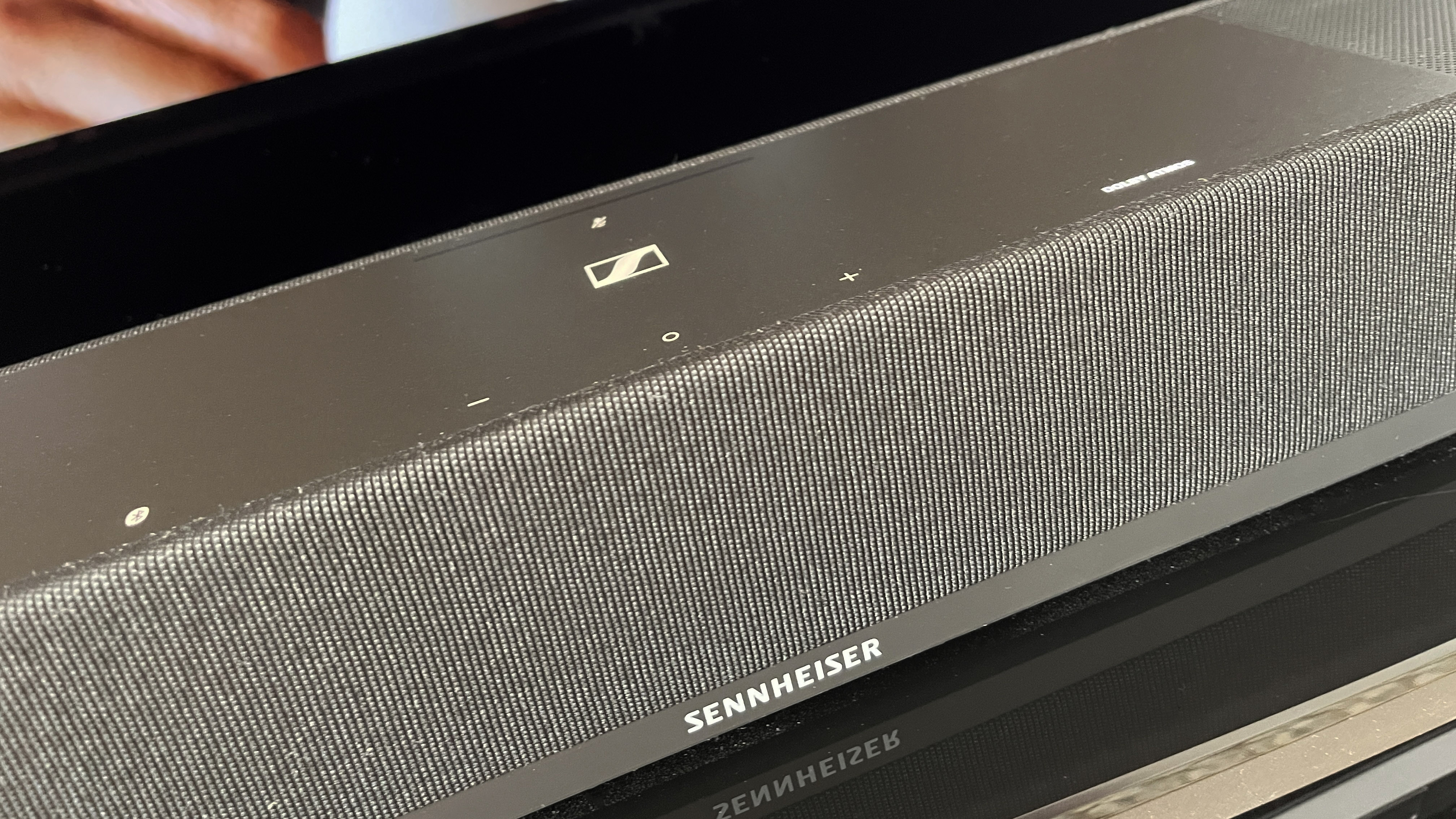
The Ambeo Plus is not a small soundbar - but compared to its bigger brother, it’s a stripling. At 75 x 1051 x 121mm (HxWxD) it’s roughly the same width as a 48in TV - and unless it’s one of those TVs that sits very low on its stand, the soundbar isn’t tall enough to foul the bottom of the screen. A weight of around 6.3kg is about a third of that of the original Ambeo, so you shouldn’t need to reinforce your shelves.
As is standard Sennheiser practice, the build and finish of the Ambeo Plus is impressive. The plastics used in the main body and across the top surface feel good, and the acoustic cloth that wraps around all the way around the front, back and sides of the ‘bar is tactile too. Everything is put together with obvious care, and everything is finished smoothly too. And unlike one or two rival designs we could mention, there are no glass surfaces here to reflect the light from your TV screen.
It’s a similarly thorough and satisfying story when it comes to controlling the Ambeo Plus. Sennheiser includes a full-function remote control in the soundbar’s packaging - and it’s no credit card-sized clicky abomination, either. Its chunky chassis looks and feels good, and it covers every major function. Some backlighting would be nice, sure, but let’s not ask for the moon when we already have the stars.
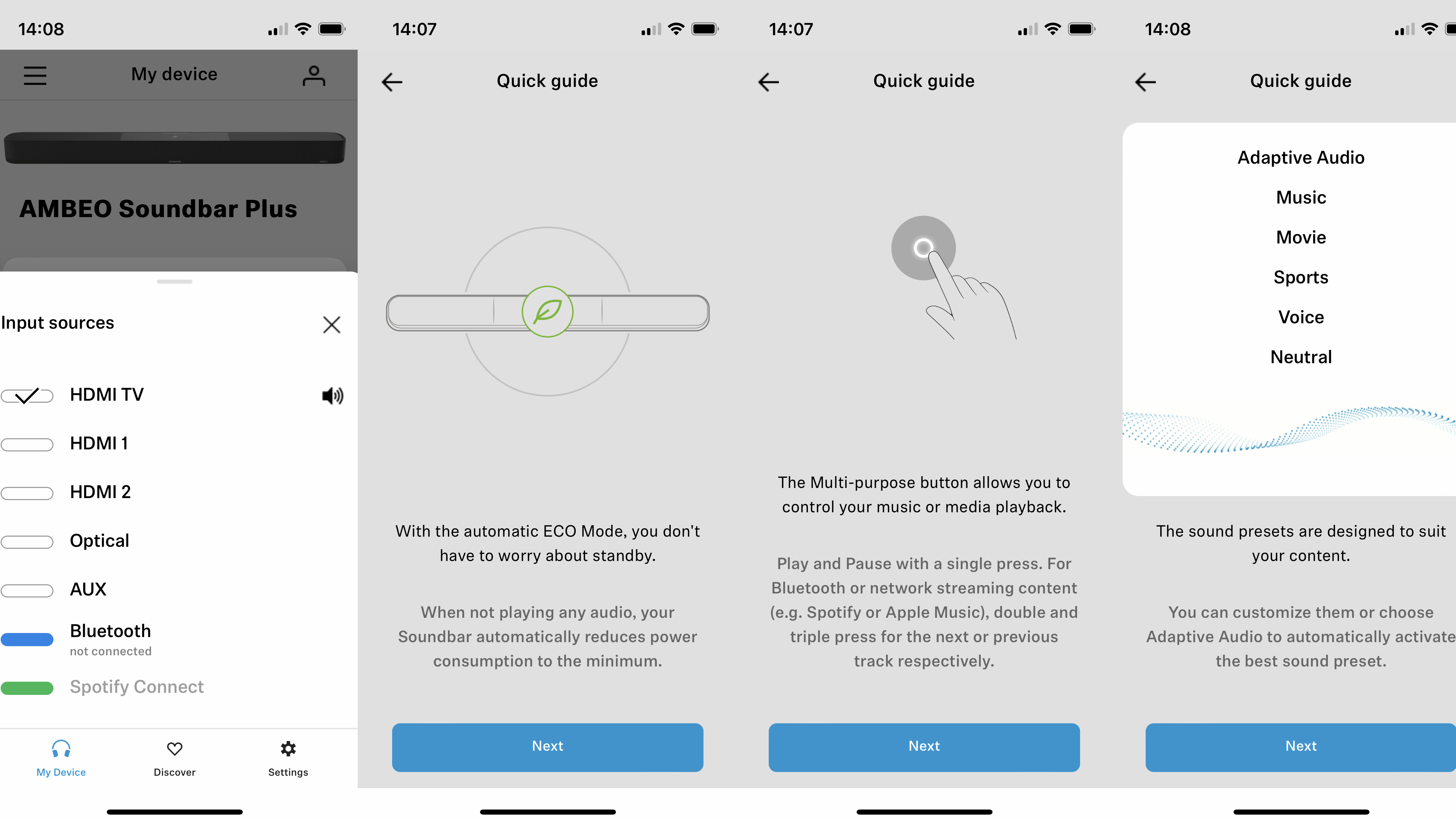
Even better, though, is the Sennheiser Smart Control app for iOS and Android devices. As well as input selection, volume control and all the other niceties like audio EQ presets, firmware updates and so on, here’s where you can set up Amazon Alexa voice assistance (the soundbar features four very responsive far-field mics) and calibrate the Ambeo Plus to its specific environment.
The app's set-up process is rapid and accurate - which, in fact, is a good way to describe the app in general. It may not be the most visually exciting, but it’s stable and useful - which is more than we can say for some alternative designs.
You may be the sort of person who likes to get fully hands-on, though - and Sennheiser has you covered. On the top surface of the Ambeo Plus, between the perforated speaker grilles, there are a selection of capacitive touch-controls, along with a tell-take light letting you know what the soundbar is up to.
Sennheiser Ambeo Plus review: Verdict
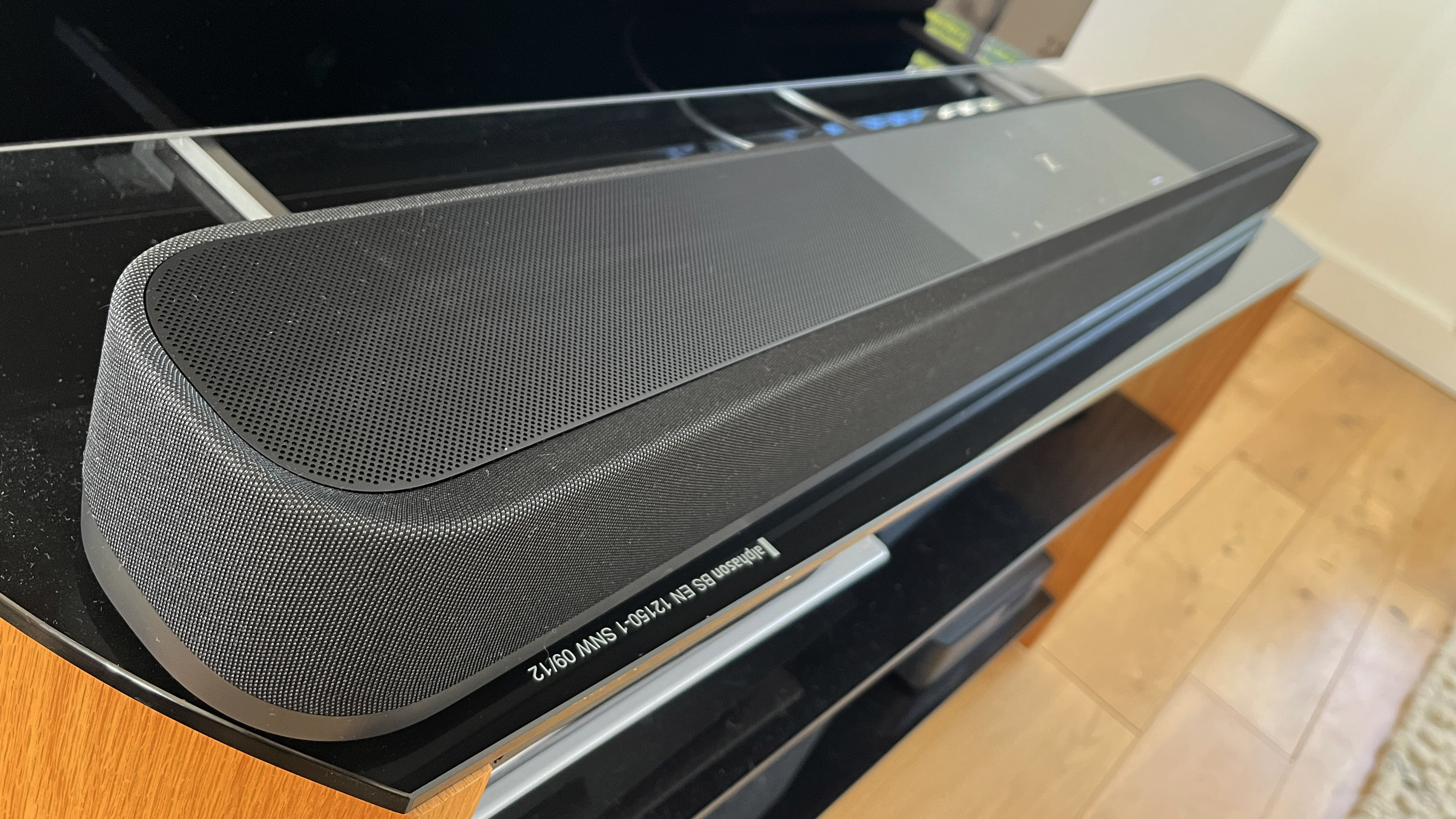
It’s even more expensive than its most expensive rivals, yet the Sennheiser Ambeo Plus still seems like money very well spent indeed.
If you want a proper taste of home cinema spatial audio excitement, but don’t fancy a great big soundbar (let alone a room full of speakers), Sennheiser will cater for you - and in some style.
Also consider
For Sennheiser Ambeo Plus money, Samsung will sell you its whistle-and-bells HW-Q990B soundbar-with-wireless-rear-speakers-and-a-subwoofer package. Yes, you’ll have more stuff to accommodate as a result - but as far as ‘immersive sound’ is concerned, this is a beauty.
If you want to restrict the amount of stuff you need to find space for, though, and don’t want to spend Ambeo Plus money, Sony’s HT-A7000 is well worth checking out. Like the Sennheiser it’s just one component (although it’s bigger, and consequently needs a bigger TV to sit beneath if it’s not going to look a bit daft), and like the Sennheiser it does fine work with spatial audio soundtracks.
Sign up to the T3 newsletter for smarter living straight to your inbox
Get all the latest news, reviews, deals and buying guides on gorgeous tech, home and active products from the T3 experts
Simon Lucas is a freelance technology journalist and consultant, with particular emphasis on the audio/video aspects of home entertainment. Before embracing the carefree life of the freelancer, he was editor of What Hi-Fi? magazine and website – since then, he's written for titles such as Wired, Metro, the Guardian and Stuff, among many others. Should he find himself with a spare moment, Simon likes nothing more than publishing and then quickly deleting tweets about the state of the nation (in general), the state of Aston Villa (in particular) and the state of his partner's cat.
-
 Warning: Ciele’s refreshed Elite Collection may cause excessive garment envy on race day
Warning: Ciele’s refreshed Elite Collection may cause excessive garment envy on race dayFlex on your run crew with Ciele’s latest drop
By Matt Kollat Published
-
 Smeg adds a touch of navy sophistication to its iconic breakfast set
Smeg adds a touch of navy sophistication to its iconic breakfast setIt's a minimalist's dream
By Lizzie Wilmot Published
-
 My most anticipated Netflix movie of the year gets a wild new trailer
My most anticipated Netflix movie of the year gets a wild new trailerHavoc looks pretty unbelievable
By Max Freeman-Mills Published